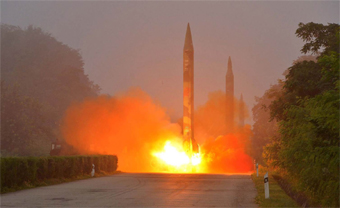
Image courtesy North Korean media
North Korean Ballistic Missile
Test Draws Condemnation
| published September 6, 2016 |
By Thursday Review staff
Despite international sanctions and worldwide protests, the government of North Korea says it is proceeding full bore with plans to develop ballistic missiles and other weapons in order to deliver nuclear warheads to its enemies.
The military of North Korea launched at least three Rodong middle-range ballistic missiles on Monday. The rockets were fired in the direction of Japan but landed in the waters off the coast of the Korean Peninsula, according to military and media sources in South Korea and Japan. Both Japan and South Korea monitored the missile tests, and all three missiles entered the air space over the ocean routinely monitored by Japan’s air defenses.
The missiles were fired in rapid succession into the waters near the Sea of Japan, travelling roughly 650 miles before splashing into the sea. Both South Korea and Japan say that the rockets were launched without air defense or navigational warnings and without any effort by Pyongyang to alert neighboring countries that tests were being conducted.
State run media in Pyongyang announced that the tests were successful, and that leader Kim Jong-un was satisfied with the results as part his long range plan to develop a nuclear weapons program, despite a variety of international and U.N. sanctions and limitations. Kim also told his citizenry that the nation was redoubling its efforts to become a great military power.
The ballistic missile tests come just weeks after North Korea again tested submarine-launched rockets, and only months after similar rocket tests were conducted despite international rules against such testing.
The U.S. State Department called the unannounced tests reckless, and a threat to both civilian and commercial air and sea traffic. South Korea and Japan each condemned the tests, calling the launches provocative, and declared the tests outright violations of international rules against such activity.
Intelligence and military analysts who have studied the data on the tests say that all three missiles traveled along a similar trajectory, landing in more-or-less the same spot in the waters between the Korean Peninsula and Japan, suggesting that North Korea’s military has greatly improved the targeting capabilities of its missiles and rockets. Such accuracy would enable North Korea to attack not only a specific city or town, but also target with reliability a ship passing through the range of the missiles.
North Korea’s presumptive ally, China, called for “calm” among all the parties affected by the tests, and suggested that the situation inside North Korea was politically “complex and sensitive.” Some analysts of both North Korea and China say that China’s language in the statement could be interpreted as Beijing’s way of saying that Kim Jong-un is acting out for internal consumption and internal propaganda. But critics of this interpretation say that North Korea’s actions carry real consequences for the international community and pose genuine dangers to the Pacific region.
Related Thursday Review articles:
North Korea Calls US Sanctions Act of War; Keith H. Roberts; Thursday Review; July 17, 2016.
North Korea Claims Hydrogen Bomb Test ; R. Alan Clanton; Thursday Review; January 6, 2016.
